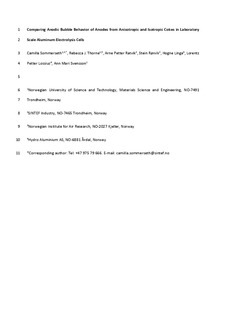Comparing Anodic Bubble Behavior of Anodes from Anisotropic and Isotropic Cokes in Laboratory Scale Aluminum Electrolysis Cells
Sommerseth, Camilla; Thorne, Rebecca Jayne; Ratvik, Arne Petter; Rørvik, Stein; Linga, Hogne; Lossius, Lorentz Petter; Svensson, Ann Mari
Journal article, Peer reviewed
Accepted version

Åpne
Permanent lenke
http://hdl.handle.net/11250/2637110Utgivelsesdato
2019Metadata
Vis full innførselSamlinger
- Institutt for materialteknologi [2534]
- Publikasjoner fra CRIStin - NTNU [37727]
Originalversjon
Journal of the Electrochemical Society. 2019, 166 (13), E438-E452. 10.1149/2.0481913jesSammendrag
During production of aluminum in Hall-Héroult cells, carbon anodes electrochemically oxidize to form mainly CO2. The CO2 bubbles block the anode working surface during growth and coalescence, leading to cell voltage loss and voltage oscillations. Lower grade isotropic petroleum cokes are currently being introduced to anodes worldwide, but little is known about effects of coke quality on the unavoidable voltage losses linked to bubble formation. To investigate this, a pilot carbon anode series was made with various blended ratios of isotropic to anisotropic coke. The anodes were characterized with respect to voltage oscillations related to bubble formation and release, wettability toward electrolyte and surface roughness before and after electrolysis. Results showed that voltage noise caused by gas bubbles was reduced for anodes containing isotropic coke. For blended anodes of isotropic and anisotropic coke, the potential oscillation amplitude was reduced by ∼0.19 V compared to a 100% anisotropic coke anode. The percentage of the anode surface screened by gas bubbles was also reduced as isotropic coke was introduced. Increased wettability between electrolyte and two anodes containing isotropic coke was observed after anode polarization. The reduced bubble screening on the anode surface was attributed to better wetting between anode and electrolyte.